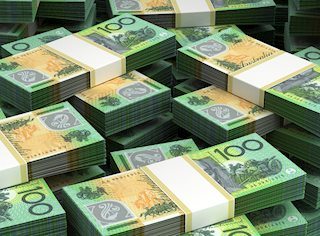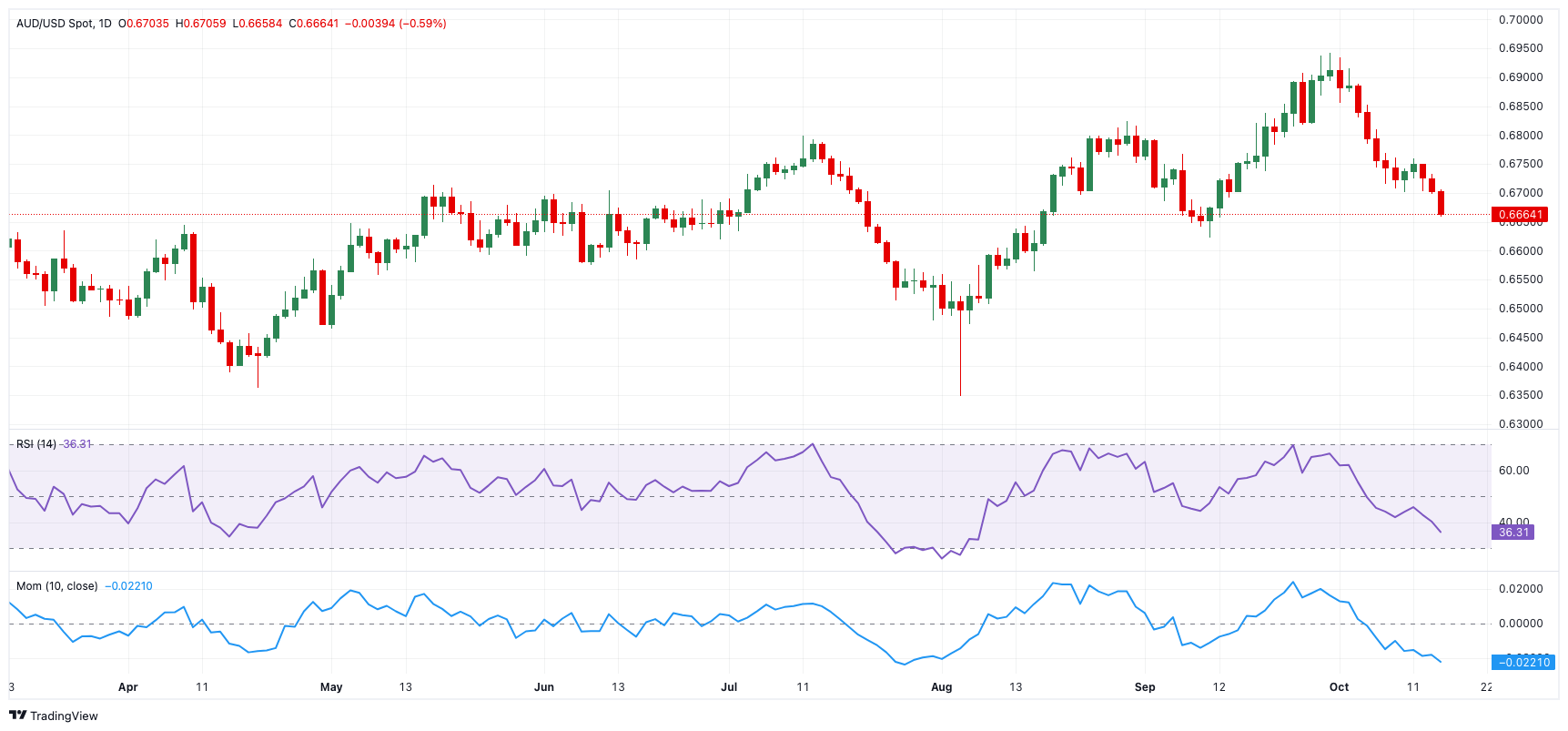AUD/USD Price Forecast: Further retracements now seem likely
Premium|
You have reached your limit of 5 free articles for this month.
Take advantage of the Special Price just for today!
50% OFF and access to ALL our articles and insights.
Subscribe to Premium- AUD/USD maintained its bearish trend unchanged below 0.6700.
- The US Dollar kept its bullish bias in place and rose to multi-week tops.
- Next of relevance on the docket will be the Australian labour market report.
AUD/USD faced extra selling pressure on Wednesday, this time breaking below the key support at 0.6700 the figure and reaching new five-week lows.
The Australian Dollar’s bearish momentum was largely due to further gains in the US Dollar (USD) as well as incessant scepticism around China’s latest stimulus efforts, making traders cautious.
In addition, the Aussie Dollar failed to temper its decline despite slight gains in both copper prices and iron ore prices, always amidst doubts about how effective China’s stimulus will really be.
Looking at China, deflation concerns grew deeper in September, with official data underscoring the country’s ongoing economic struggles. Over the weekend, a press conference left investors unsure about the scope and impact of any upcoming stimulus efforts aimed at reviving the economy.
On the monetary policy front, the Reserve Bank of Australia (RBA) held its cash rate steady at 4.35% in its September meeting. While the RBA acknowledged inflation risks, Governor Michele Bullock emphasized that a rate hike is not on the table for now.
Minutes from the RBA’s meeting signalled a more dovish stance compared to August, when there was guidance suggesting stable rates for the near future.
Market sentiment currently suggests a 50% chance of a 25-basis-point rate cut by the end of the year. The RBA is expected to be one of the last G10 central banks to cut rates, likely in response to slowing economic growth and easing inflation pressures.
While potential rate cuts from the Federal Reserve could help the AUD/USD recover later this year, uncertainties surrounding China’s economic outlook and stimulus remain a major headwind.
In Australia, Westpac’s Leading Index for September showed no change on a monthly basis. Additionally, Assistant Governor Sarah Hunter noted that the RBA is closely watching data to see if inflation will stay persistent and is "very mindful and watchful" of central bank policies in other countries.
Next on tap in Oz will be the publication of the Leading Index gauged by Westpac, along with the speech of the RBA’s Hunter.
AUD/USD daily chart
AUD/USD short-term technical outlook
Extra losses might send the AUD/USD down to its October low of 0.6657 (October 16), ahead of the September low of 0.6622 (September 11), which is still supported by the key 200-day SMA.
On the bright side, the first challenge arrives at the 2024 high of 0.6942 (September 30), just before the critical 0.7000 milestone.
The four-hour chart shows an acceleration of the downtrend. That said, the initial support is 0.6657, followed by 0.6622. On the upside, first resistance is at 0.6758, just ahead of the 200-SMA at 0.6772 and the 100-SMA at 0.6807. The RSI entered the oversold zone around 29.
- AUD/USD maintained its bearish trend unchanged below 0.6700.
- The US Dollar kept its bullish bias in place and rose to multi-week tops.
- Next of relevance on the docket will be the Australian labour market report.
AUD/USD faced extra selling pressure on Wednesday, this time breaking below the key support at 0.6700 the figure and reaching new five-week lows.
The Australian Dollar’s bearish momentum was largely due to further gains in the US Dollar (USD) as well as incessant scepticism around China’s latest stimulus efforts, making traders cautious.
In addition, the Aussie Dollar failed to temper its decline despite slight gains in both copper prices and iron ore prices, always amidst doubts about how effective China’s stimulus will really be.
Looking at China, deflation concerns grew deeper in September, with official data underscoring the country’s ongoing economic struggles. Over the weekend, a press conference left investors unsure about the scope and impact of any upcoming stimulus efforts aimed at reviving the economy.
On the monetary policy front, the Reserve Bank of Australia (RBA) held its cash rate steady at 4.35% in its September meeting. While the RBA acknowledged inflation risks, Governor Michele Bullock emphasized that a rate hike is not on the table for now.
Minutes from the RBA’s meeting signalled a more dovish stance compared to August, when there was guidance suggesting stable rates for the near future.
Market sentiment currently suggests a 50% chance of a 25-basis-point rate cut by the end of the year. The RBA is expected to be one of the last G10 central banks to cut rates, likely in response to slowing economic growth and easing inflation pressures.
While potential rate cuts from the Federal Reserve could help the AUD/USD recover later this year, uncertainties surrounding China’s economic outlook and stimulus remain a major headwind.
In Australia, Westpac’s Leading Index for September showed no change on a monthly basis. Additionally, Assistant Governor Sarah Hunter noted that the RBA is closely watching data to see if inflation will stay persistent and is "very mindful and watchful" of central bank policies in other countries.
Next on tap in Oz will be the publication of the Leading Index gauged by Westpac, along with the speech of the RBA’s Hunter.
AUD/USD daily chart
AUD/USD short-term technical outlook
Extra losses might send the AUD/USD down to its October low of 0.6657 (October 16), ahead of the September low of 0.6622 (September 11), which is still supported by the key 200-day SMA.
On the bright side, the first challenge arrives at the 2024 high of 0.6942 (September 30), just before the critical 0.7000 milestone.
The four-hour chart shows an acceleration of the downtrend. That said, the initial support is 0.6657, followed by 0.6622. On the upside, first resistance is at 0.6758, just ahead of the 200-SMA at 0.6772 and the 100-SMA at 0.6807. The RSI entered the oversold zone around 29.
Information on these pages contains forward-looking statements that involve risks and uncertainties. Markets and instruments profiled on this page are for informational purposes only and should not in any way come across as a recommendation to buy or sell in these assets. You should do your own thorough research before making any investment decisions. FXStreet does not in any way guarantee that this information is free from mistakes, errors, or material misstatements. It also does not guarantee that this information is of a timely nature. Investing in Open Markets involves a great deal of risk, including the loss of all or a portion of your investment, as well as emotional distress. All risks, losses and costs associated with investing, including total loss of principal, are your responsibility. The views and opinions expressed in this article are those of the authors and do not necessarily reflect the official policy or position of FXStreet nor its advertisers.
